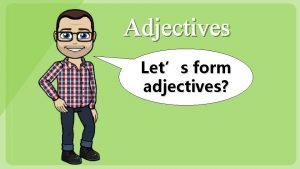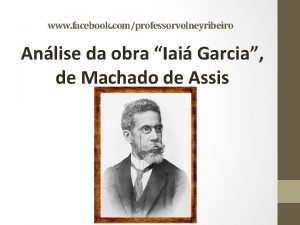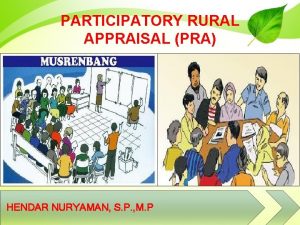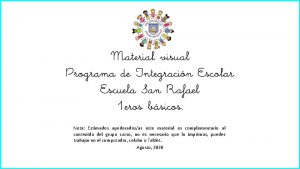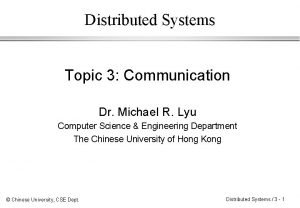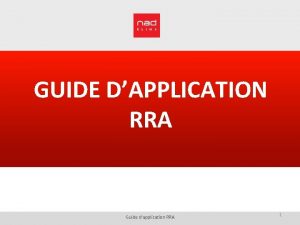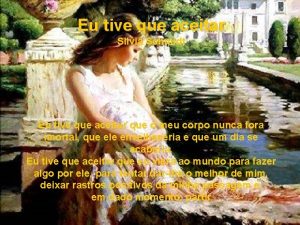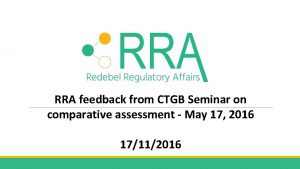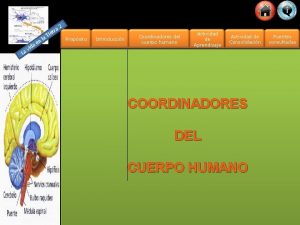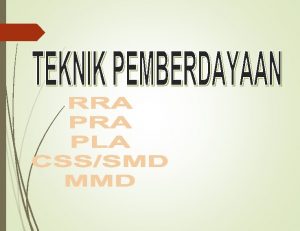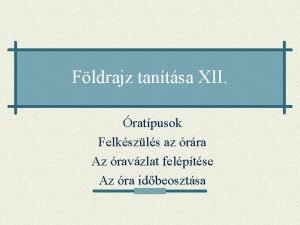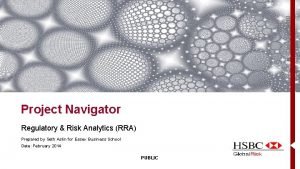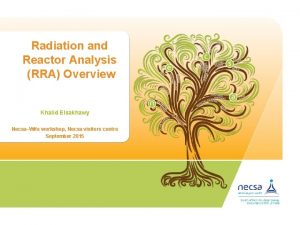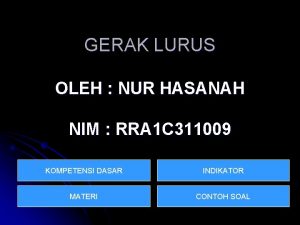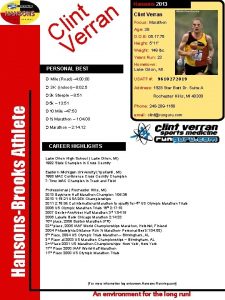N a rra tive of the Life of




















- Slides: 20

N a rra tive of the Life of F r e d e r i c k D o u g l a s s An American Slave

Objectives The ability to distinguish the purpose of a text. To comprehend the brutality of slave life. Analyze and understand the use of rhetorical devices in order to persuade the reader of the author’s purpose.

Opening Discussion What aspects or parts of your life are you able to control? What parts are you unable to control? What aspects of a slave’s life do you think he/she controlled? What parts was he/she unable to control?

About Frederick Douglass Frederick Augustus Washington Bailey, who later became known as Frederick Douglass, was born a slave in Talbot County, Maryland near Hillsboro. He escaped slavery in 1838 and went to New York city and married Anna Murray, a free colored woman. He is famously known as an American abolitionist, editor, orator, author, statesman and reformer. As one of the foremost leaders of the abolitionist movement, Douglass fought to end slavery within the United States in the decades prior to the Civil War. During the Civil War, he served as an adviser to President Abraham Lincoln and fought for the adoption of constitutional amendments that guaranteed voting rights and other civil liberties for blacks.

Autobiography Douglass' most well-known work is his autobiography, Narrative of the Life of Frederick Douglass, an American Slave, which was published in 1845. Critics frequently attacked the book as inauthentic, not believing that a black man could possibly have produced so eloquent a piece of literature. The book was an immediate bestseller, selling over 11, 000 copies and received overwhelmingly positive critical reviews.

Text Analysis Style is a writer’s distinctive way of expressing ideas – not what is said, but how it is said. Douglass uses a formal, elegant style that demonstrates his masterful command of the language. Elements that characterize style include: Tone, conveyed by choice of words and details Sentence patterns and structures Use of figurative language Use of dialogue Douglass combines crisp, factual narration with bursts of poetic language.

Text Analysis Style Reread lines 78 – 88. identify examples of metaphor, repetition and parallelism. What tone is created byt eh use of this language? What perspective on slavery does it help the author to achieve? Reread lines 159 – 167. note that Douglass chooses to convey this dialogue without quotations. What effect does he achieve instead by repeating the word ‘that’?

Reading Skill Author’s Purpose An author creates a work to achieve a specific purpose, or goal. In general, an author writes to inform, to express thoughts or feelings, to persuade, or to entertain. However, a complex work will often have more than one purpose. Douglass wrote his autobiography mainly to persuade readers that slavery should be abolished. To achieve this purpose, he described the physical realities that slaves endured and his responses to his life as a slave.

Reading Skill Author’s Purpose Reread lines 31 – 43. What details does Douglass use to inform his readers about the working conditions of slaves? Reread lines 113 – 144. How does this paragraph further the author’s purpose?

Reasons for Writing an Autobiography To present the reality of slavery. To generate enthusiasms for the abolitionist struggle. In his own words, “Sincerely and earnestly hoping that this little book may do something toward throwing light on the American slave system, and hastening the glad day of deliverance to the millions of my brethren in bonds--faithfully relying upon the power of truth, love, and justice, for success in my humble efforts—and solemnly pledging my self anew to the sacred cause. ”

In His Times … Slaves did not know when they were born and couldn’t determine how old they were. Children born into slavery were denied the privilege of knowing their age and their parentage. A few lucky ones had the liberty to see their mother 4 or 5 times in their lifetime. “ I do not recollect of ever seeing my mother. She made her journeys to see me in the night, traveling the whole distance of 12 miles on foot. Her death soon ended what little we could have while she lived, and with it her hardships and suffering ”.

He Recalls … Whipping and selling unmanageable slaves, naked children, want of time to sleep over want of beds, fiendish barbarity of slave holders, fields of blood and blasphemy. “I have seen him whip a woman, causing the blood to run half an hour at the time; and this, too, in the midst of her crying children, pleading for their mother's release. He seemed to take pleasure in manifesting his fiendish barbarity ”. Horses valued more than slaves, never say a word against a complaint, luxury of whipping the servants, penalty of telling the truth, ‘still tongue makes a wise head’, disgrace to be a poor man's slave.

Organization of the Book The book is divided into eleven chapters describing his life, from birth into slavery to escape into freedom. In the first few chapters, he gives an account of his childhood and narrates few incidents revealing the horrible character of slavery and the devilish atrocities inflicted upon them. In the next few chapters, Douglass describes his struggle towards freedom at Baltimore. He speaks about his everlasting and unabated desire to learn to read, realizing that education is a pathway from slavery to freedom. Towards the end, he describes his efforts in planning to escape to the north, to become ‘his own master’.

The Genre – A Slave Narrative The slave narrative is a literary form which grew out of the experience of enslaved Africans in the New World. Some six thousand former slaves from North America and the Caribbean gave an account of their lives during the 18 th and 19 th centuries The Genre soon emerged as a mainstay of African American literature. North American and Caribbean slave narratives can be broadly categorized into three distinct forms: Tales of religious redemption, Tales to inspire the abolitionist struggle, and Tales of progress. The tales written to inspire the abolitionist struggle such as Frederick Douglass's autobiography, are the most famous because, they tend to have a strong autobiographical motif.

Analyzing the book … Throughout the text it can be noticed that Douglass makes reference not just to the cruelty of slavery as an institution, but also to the way it has become institutionalized through things like politics, law, religion, and social practices. “ There is no legal protection in fact, whatever there may be in form, for the slave population; and any amount of cruelty may be inflicted on them with impunity. Is it possible for the human mind to conceive of a more horrible state of society? ”

Analyzing the Book … Often, the reader is left to figure out the psychology behind the awful incidents described while Douglass simply explains his feelings and reactions. The plantation where slaves were employed, is described as being so big that many slaves never even saw their master and vice versa. Douglass details an instance in which a slave was heading down a road and encountered his master without knowing who he was. When the unknown master asked the slave how he was treated and the slave responded that he was ill-treated, he was made an example of by being chained up and sold to a slave trader—one of the worst punishments.

Analyzing the book … Douglass often interrupts his own story to tell tales of other slaves. He does this to emphasize his points and show the extent of the cruelty and wrong of slavery even if he wasn’t directly involved in the event he describes. These side stories work to tell the whole tale of slavery by showing the extent to which the cruelty was manifest. “ The slave auctioneer's bell and the church-going bell chime in with each other, and the bitter cries of the heart-broken slave are drowned in the religious shouts of his pious master ”. A turning point in the narrative comes after an incident in which Douglass revolted back against his master, for the first time in his life. He describes this incident as the turning point in his life, for it rekindled the flame of hope for freedom in his heart.

Analyzing the book … Metaphorical References : Douglass uses innumerous metaphors throughout his autobiography. ‘A still tongue makes a wise head'. ‘It is worth a half-cent to kill a nigger and a half-cent to bury one’ ‘Learning would spoil the best nigger in the world and would make him unfit for a slave’. ‘ Education - the pathway from slavery to freedom’ ‘ It is wise to bear the ills present than to fly to those unknown’ ‘Escape from a den of hungry lions’ ‘The paper (The Liberator) is my meat and drink'

Analyzing the book … Words used : Douglass uses a variety of words to color his experiences. Torture : atrocity, hardships, suffering, horror, terror. Slave holders : fiendish, barbarous, cruel, artful, obdurate. Slaves : weak, emaciated, scarred, painful gnawing of hunger. Slavery : blood, blasphemy, dehumanizing character, wretchedness Feelings of Slaves : depressed spirit, ineffable sadness, thrill of horror, unbearable mental torture, torment, sting, unutterable anguish, horrid, dread, apprehension. Education/Freedom : prosperity, divine providence, joy, rapture, happiness, unabated interest, blessedness, bliss.

Discussion How did Master Thomas respond when Douglass asked for protection from Covey? What does this show you? How was the battle with Covey a turning point in Douglass’s life as a slave? Based on his final battle with Mr. Covey, how do you think Douglass feels about the following topics: Individual rights Self-reliance Resistance to tyranny
 Urpris
Urpris Nao tive filhos não transmiti a nenhuma criatura
Nao tive filhos não transmiti a nenhuma criatura Características naturalismo
Características naturalismo Essa noite eu tive um sonho um sonho diferente
Essa noite eu tive um sonho um sonho diferente Contoh rra dan pra dalam penyuluhan pertanian
Contoh rra dan pra dalam penyuluhan pertanian Palabras con rra rre rri rro rru
Palabras con rra rre rri rro rru Nad rra
Nad rra R rr rra protocol
R rr rra protocol R rr rra protocol
R rr rra protocol Hình ảnh bộ gõ cơ thể búng tay
Hình ảnh bộ gõ cơ thể búng tay Bổ thể
Bổ thể Tỉ lệ cơ thể trẻ em
Tỉ lệ cơ thể trẻ em Gấu đi như thế nào
Gấu đi như thế nào Tư thế worm breton
Tư thế worm breton Hát lên người ơi
Hát lên người ơi Môn thể thao bắt đầu bằng chữ f
Môn thể thao bắt đầu bằng chữ f Thế nào là hệ số cao nhất
Thế nào là hệ số cao nhất Các châu lục và đại dương trên thế giới
Các châu lục và đại dương trên thế giới Công thức tiính động năng
Công thức tiính động năng Trời xanh đây là của chúng ta thể thơ
Trời xanh đây là của chúng ta thể thơ
